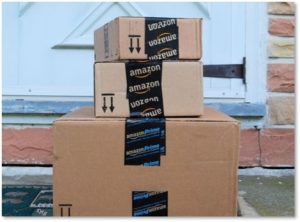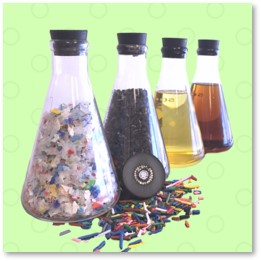Just in time for the holiday season of over-consumption, we are hearing more about the impact of plastic waste on the economy and the environment. Here are just a few of them:
- “Your Recycling Gets Recycled, Right? Maybe. Maybe Not” by Livia Albeck-Ripka – The New York Times
- “The Number of Sea Creatures Choking On Plastic Will Put You Off Ever Buying Another Bottled Drink” by Sara C. Nelson — HuffPost
- “Is This the End of Recycling” by Alana Semuels – The Atlantic
And it’s only going to get worse. The Environmental Protection Agency estimates that Americans generate 25% more waste between Thanksgiving and New Year’s than during the rest of the year. This comes to an additional one million tons per week.
Filling the Waste Stream
 The buying and giving of Christmas presents will generate an enormous amount of trash from shipping, packing, and carrying — much of it plastic.Many people would rather save two bucks by ordering online and then dealing with cardboard boxes, styrofoam peanuts, bubble wrap, inflated plastic pillows, and other materials required to get the product from the company to the consumer in one piece
The buying and giving of Christmas presents will generate an enormous amount of trash from shipping, packing, and carrying — much of it plastic.Many people would rather save two bucks by ordering online and then dealing with cardboard boxes, styrofoam peanuts, bubble wrap, inflated plastic pillows, and other materials required to get the product from the company to the consumer in one piece
Small items go into big boxes that are filled with plastic, all of which ends up in the waste stream.”But that’s okay, right? All I have to do is put it out on the curb and it disappears, right?” Wrong. “All right, all right, I’ll recycle. Feel better now?” Well, no.
Plastic Trash is Piling Up
Since China stopped accepting shipments of plastic and paper waste in 2018, our carefully recycled materials have been piling up here in the U.S. Many communities have begun burning it or burying it in landfills, despite the air and land pollution, because they have no choice.
Choice: that’s the crux of the matter. Because we, the consumer, often have no choice in what we buy, whether it’s food at the market, food in a restaurant, or detergent to wash our clothes.
The manufacturers decide what containers we get for a lot of consumer materials and they choose the cheapest possible material. Whether you’re buying spray cleaner for your windows or yogurt for your lunch, your can choose containers that are plastic, plastic, or plastic.
No Consumer Right of Refusal
 We can’t say, “Oh, no, I’d rather buy that in a glass or cardboard container,” because there often aren’t any on the shelves. Regardless of brand, size, or type of beverage, for example, the shelves will be crowded with plastic. Sometimes we can choose a cardboard box of detergent or carton of milk but that’s a rare option.
We can’t say, “Oh, no, I’d rather buy that in a glass or cardboard container,” because there often aren’t any on the shelves. Regardless of brand, size, or type of beverage, for example, the shelves will be crowded with plastic. Sometimes we can choose a cardboard box of detergent or carton of milk but that’s a rare option.
In a restaurant, we can say, “No straw, please,” but that’s about it. Chances are, if the server refills your glass, you will get a straw anyway. Order a drink in a fast-casual restaurant like Panera Bread and drinks come in a plastic cup. At least the trays are re-usable plastic and the utensils are real silverware.
One-Way Responsibility
One reason manufacturers find plastic so cheap is that they don’t have to pay for anything but its purchase. Essentially, they take no responsibility for the consequences of their decisions, forcing customers to pollute but washing their own hands of it. If fees were attached to plastic packaging, they might make over decisions. Right now, companies sell what works best for their profit margins and communities bear the burden of disposal.
 This could work differently. Imagine if:
This could work differently. Imagine if:
- Companies had to add a disposal fee to the price of any product they package in plastic.
- Restaurants had to add a disposal fee to the price of their food and beverages they serve on or with plastic.
- Restaurants had to add a disposal fee for leftovers (doggy bags) put in plastic containers.
- Companies were forced to create transfer stations and recycling centers to deal with all products they package in plastic.
- Companies had to pay a recycling fee for the plastic bags they purchase.
- Restaurants that use plastic to serve food had to add recycling bins for every location.
Those measures just might change the consumer dynamic. We would make different decisions and that might drive the companies to do the same.
Taking Charge of Plastic Waste
I sometimes think that checkout clerks get a bonus for every plastic bag they hand out. When I forget to bring a re-usable tote bag, as I did at Target this afternoon, the clerk used three plastic bags for what would have fit easily into one tote.
I have many of these re-usable tote bags yet somehow forget to take them with me to the store. My next step is to just put a bunch of them in the back seat of my car so I have one—in the right size—whenever I go to a store or supermarket.
With plastic waste piling up around the country, we have to take charge of reducing plastic waste ourselves. The towns of Concord and Sudbury, MA, banned single-use plastic water bottles years ago. They also banned plastic bags. My town voted last month to ban plastic bags by June of 2020 and Massachusetts will probably pass a state-wide ban this year. This stops the problem at its source. After all, if you can’t use them, people don’t have to dispose of them.
Yes, the stores and restaurants complained. But they figured out alternatives and have continued to prosper.
Converting Plastic Waste
Perhaps some of the bright young people will invent solutions to the problem of plastic waste. I forget what letter of the alphabet identifies today’s young people but they have taken on the role of activist in a number of areas—a role other generations have ignored. Including my own.
 As I have said before, we need a way to convert plastic waste into energy that doesn’t require a multi-million-dollar investment in a highly sophisticated facility. That would create a ready market for the bales and bundles currently being buried or burned.
As I have said before, we need a way to convert plastic waste into energy that doesn’t require a multi-million-dollar investment in a highly sophisticated facility. That would create a ready market for the bales and bundles currently being buried or burned.
- A new set of emerging technologies known as plastics-to-fuel is helping to convert non-recycled plastics into an array of fuels, crude oil and industrial feedstocks.
- Digital Trends reports that a chemical conversion process can turn 90 percent of polyolefin waste — the polymer behind widely used plastic polyethylene — into high-quality gasoline or diesel-like fuel. There is some progress on this front.
- Cold plasma pyrolysis makes it possible to break waste plastics down into hydrogen, methane and ethylene. Both hydrogen and methane can be used as clean fuels, as they only produce minimal amounts of harmful compounds such as soot, unburnt hydrocarbons and carbon dioxide (CO₂).
Making Plastic Waste Valuable
 These are good ideas not just because they help get rid of plastic waste. Using them would also give such waste a monetary value that would provide incentive for individuals, communities, and organizations to collect and convert them. Let’s make it feasible for communities to plastics-to- such technologies on a local level—or build regional conversion plants to which plastic waste can be shipped.
These are good ideas not just because they help get rid of plastic waste. Using them would also give such waste a monetary value that would provide incentive for individuals, communities, and organizations to collect and convert them. Let’s make it feasible for communities to plastics-to- such technologies on a local level—or build regional conversion plants to which plastic waste can be shipped.
We can no longer strew plastic waste around the countryside, as heedless of the consequences as Don Draper’s family leaving their picnic trash on the lawn. Is it possible to live a plastic-free life? I think it’s difficult but here are some ideas on how to go about it:
“100 Steps to a Plastic-Free Life”
We can’t all follow the 100 steps but we can each do a few of them. The journey of a thousand miles begins with a single step and we can all take a few steps to reduce the amount of plastic waste going into our landfills and oceans. Those steps will add up and make a great Christmas present for the planet.
